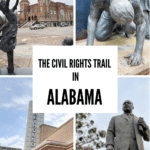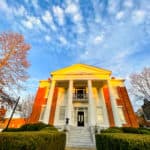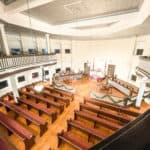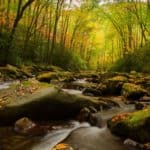You probably know the names Martin Luther King Jr and Rosa Parks. But here’s what you really need to know about civil rights in Alabama.
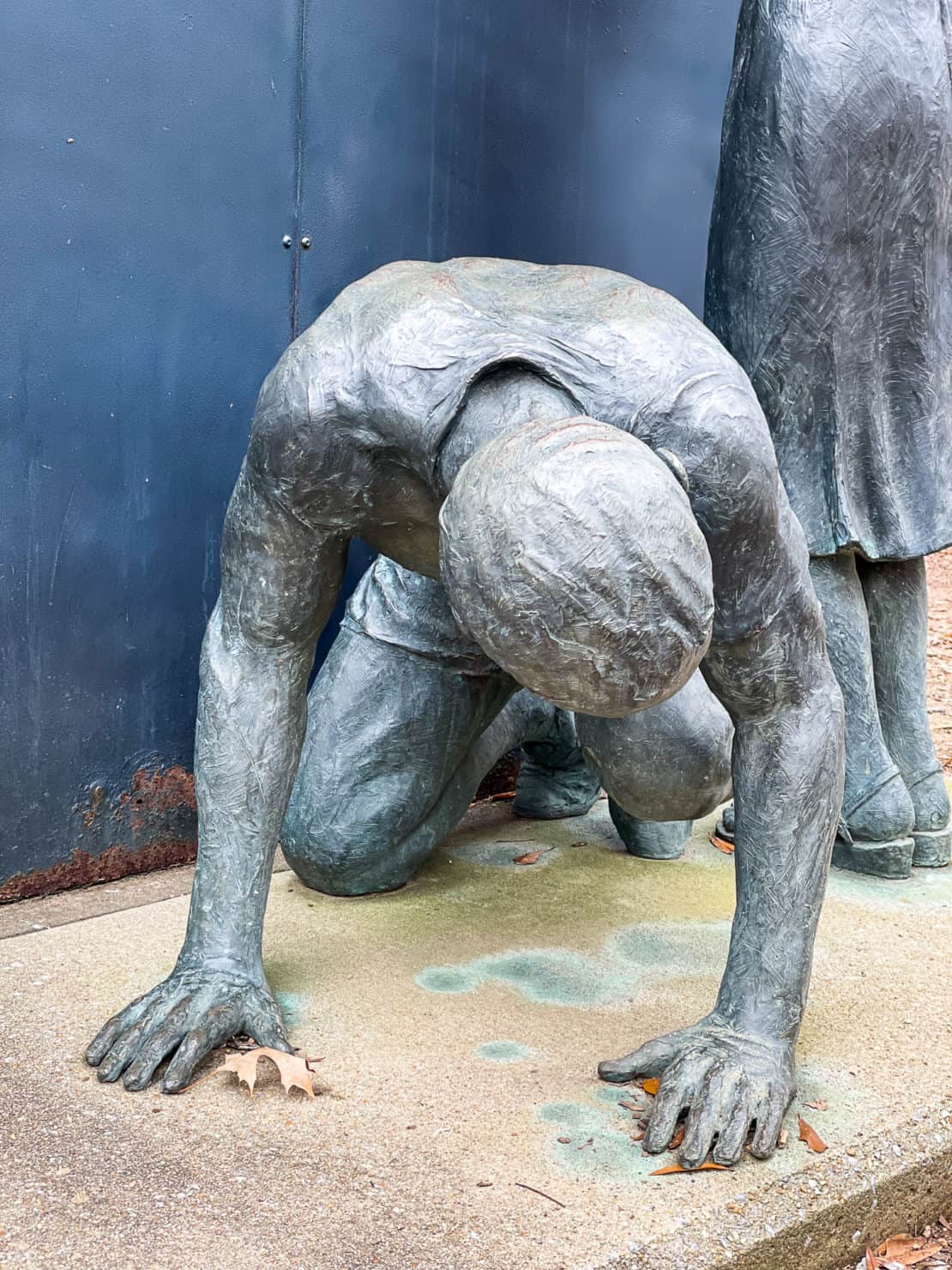
What Happened in Montgomery, Alabama
We were running late. And running.
Running and wiping ketchup from our faces, and historic ketchup at that. Moments ago, we’d been sat in a retro booth at Chris’s Hot Dogs, news clippings on the wall and Louisiana hot sauce on the table. A previous haunt of Martin Luther King Jr, Hank Williams and Elvis.
But now we were running up that hill. Making a deal with god.
We scrambled towards the church, the historic monument plaque a blur. Breathless, dishevelled, undignified, I offered our apologies to the woman we had kept waiting, Wanda.
We received the biggest beaming smile of our lives.
Wanda threw her arms out wide and with a voice like the heavens, gave us the warmest, most forgiving embrace.
Had we been her long lost children, she could not have welcomed us more.
And that was our first surprise on the civil rights trail in Alabama. Warmth and welcome.
Disclosure: this trip to learn more about civil rights in Alabama was created in partnership with Alabama Tourism Department and America As You Like It. As ever, as always, we kept the right to write what we like. It really defeats the purpose of freedom otherwise!
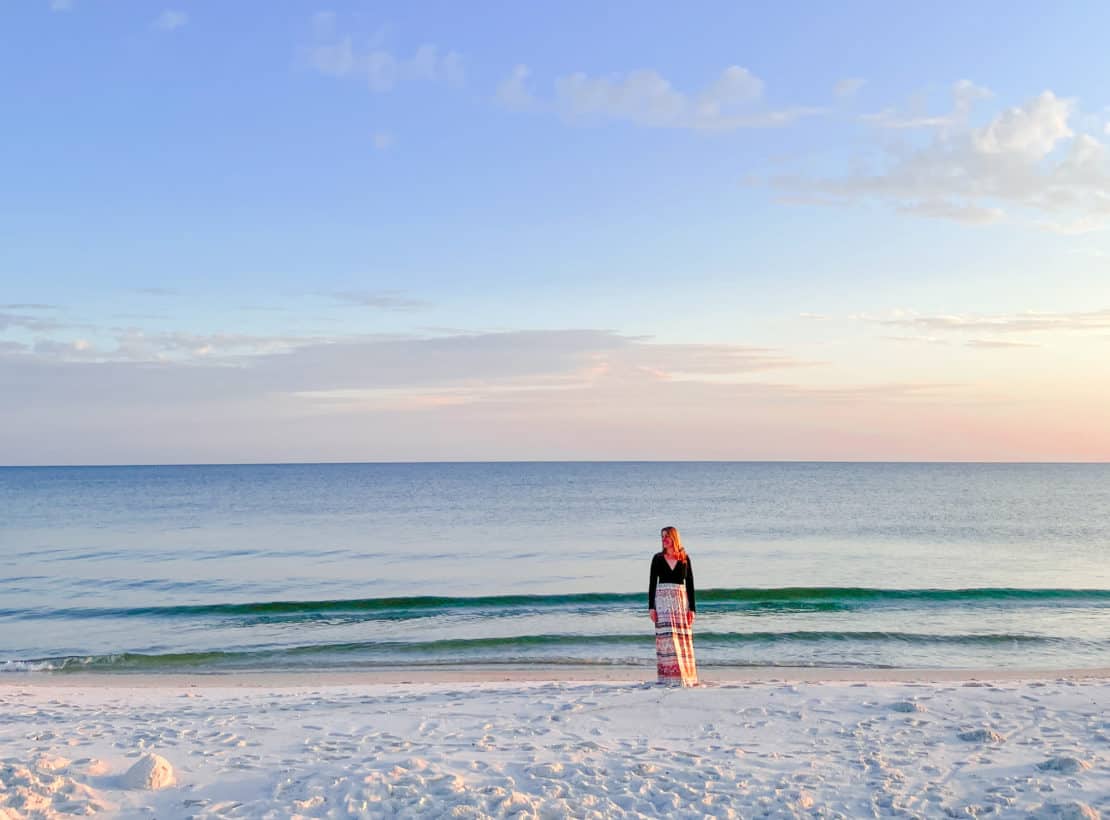
Alabama
Alabama is a curious state. Tucked in the south near Louisiana and New Orleans, its history and landscape is at once both a household name and a complete and hidden mystery. The state has more biodiversity than the rest of the US, a ridiculously beautiful soft sand coastline and record-breaking, world leading developments in sustainable beach travel.
That’s the secret side. What people are more likely to have heard about, particularly those not from the US, is the uglier, more brutal response by the state in response to the Civil Rights Movement. In fact, you can discover exactly what Alabama is known for here.
Or as many Americans I know would put it, “I’ll never go to Alabama, it’s far too racist.”
Even that term Civil Rights itself isn’t that well known beyond the land of the red, white and blue. It sounds pedestrian and tame. An irritating legislative wrinkle.
Instead, it’s the story of incomprehensible brutality and the question of what it means to be free.
More Than Mockingbird
For most Europeans, and that includes me, the vision of Alabama is the one painted by Harper Lee in To Kill a Mockingbird. Set in the Depression era of the deep south, the fictional Maycomb is a near carbon copy of the real town of Monroeville, with a white picket fences, a leafy courthouse and all.
But Alabama has cities, too. A great industrial one created in the image of the workhouse Birmingham in the UK. And a space age one in Huntsville, where real rockets await strewn on the ground.
And then there is Montgomery, Alabama. The state capital with its requisite bright white dome in the spirit of the one in DC.
And Montgomery is forever linked with these household names: Reverend Martin Luther King Junior. And Rosa Parks.
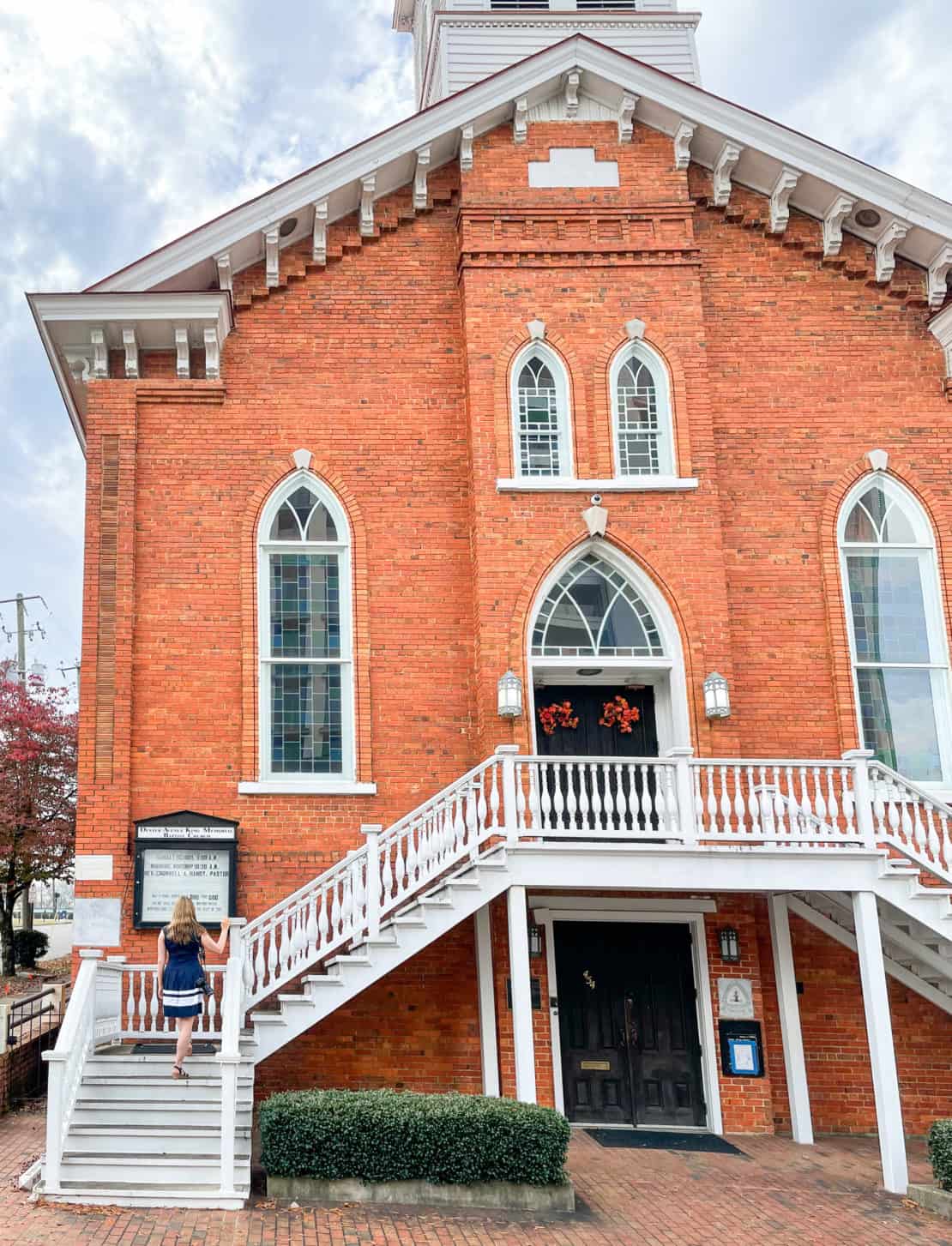
The Martin Luther King Jr Church
The church where Martin Luther King Jr preached rises up behind Wanda, its spire piercing the sky. But before she takes us in, she wants us to pause and, quite literally, look at the ground we are standing on.
There on the road are footsteps, painted in white, that stretch across the street and face in one direction.
I lift my eyes. And see the white dome of the Capitol building just metres away.
The same capitol building where Jefferson Davis was inaugurated as the first president of the Confederacy in 1861. (In short, the side which wanted to keep slavery.)
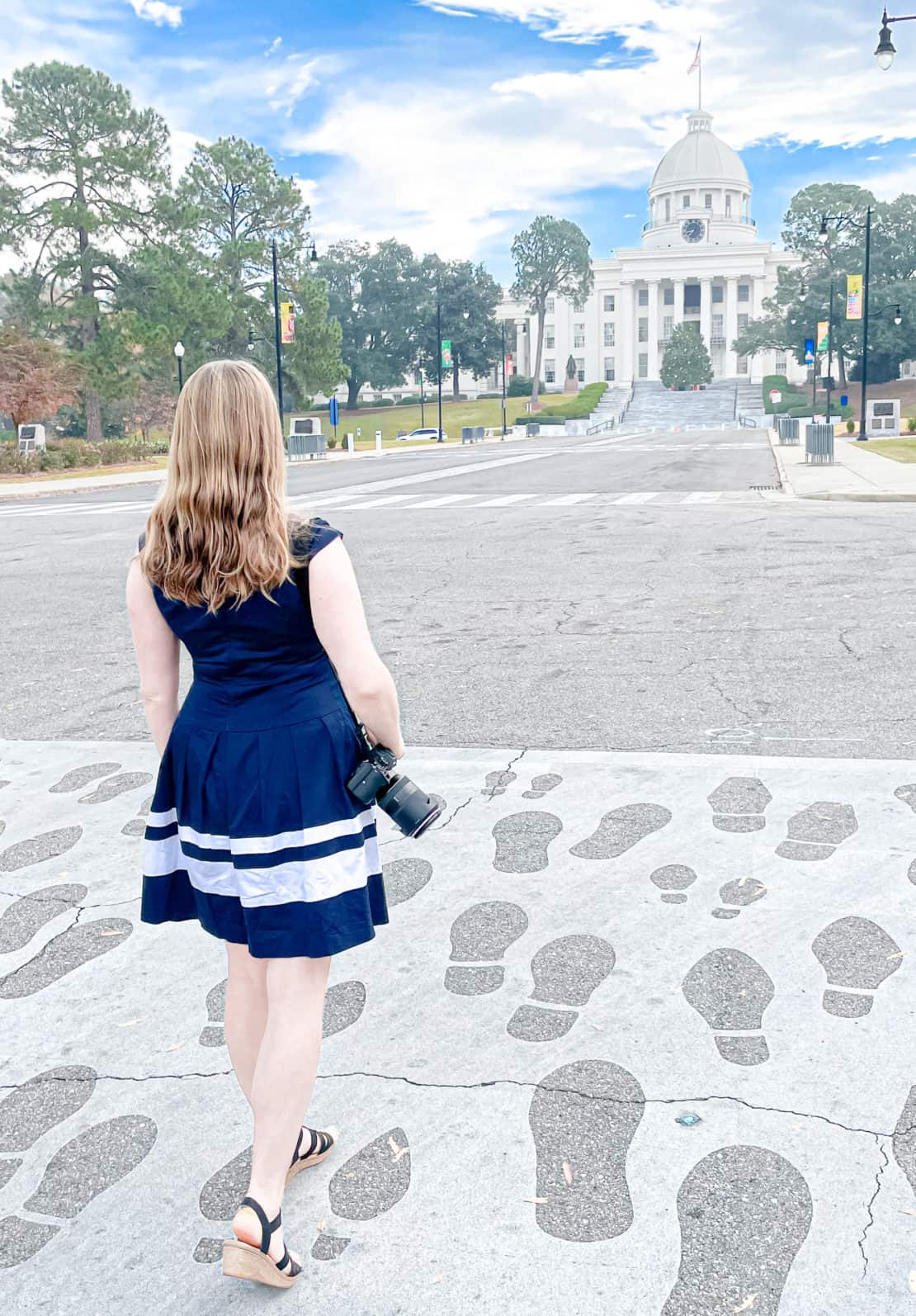
“We don’t just want you to stand and look.”
“We don’t just want you to stand and look,” Wanda told me. “We want you to walk in those footsteps.”
The original march from Selma to Montgomery ended here in 1965 as thousands campaigned for fairer voting rights for African-Americans.
At the time, Governor George Wallace refused to accept the petition, vowing to extend segregation forever. At the 50 year anniversary of the march, Martin Luther King’s daughter walked up the steps to the Capitol and was received by the then governor with tears and open arms. Barack Obama led the march. And the original governor, Wallace, attended the church to beg forgiveness.
This very same church, just footsteps away. And the same organist who plays there to this day.
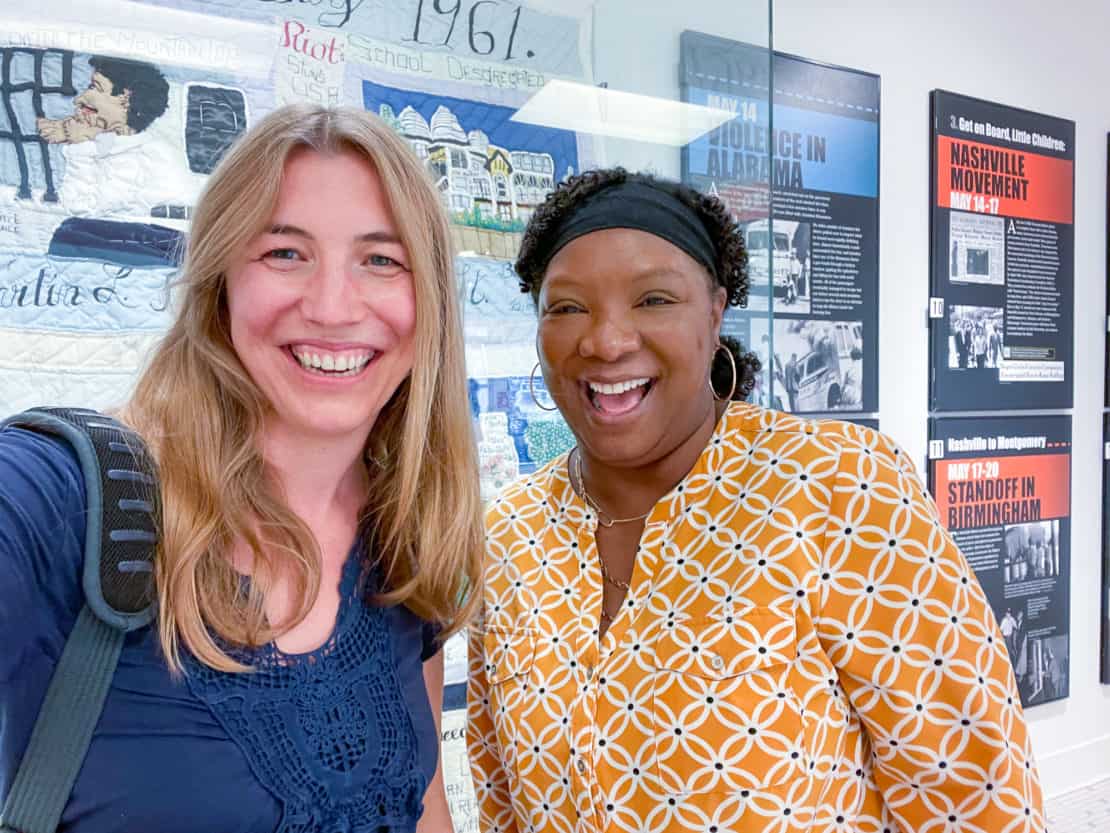
The Forgotten Civil Rights Story
Just down the road and around the corner in Montgomery is the Freedom Rides Museum, the next step on our Alabama itinerary.
“People mistake us all the time for the actual Greyhound bus stop,” a curator tells me. “Because we’ve kept the original sign.”
We arrive a little disoriented.
“Do you know what happened here?” they ask.
I’m embarrassed. “Not fully,” I reply.
“That’s OK, I didn’t either before I worked here.”
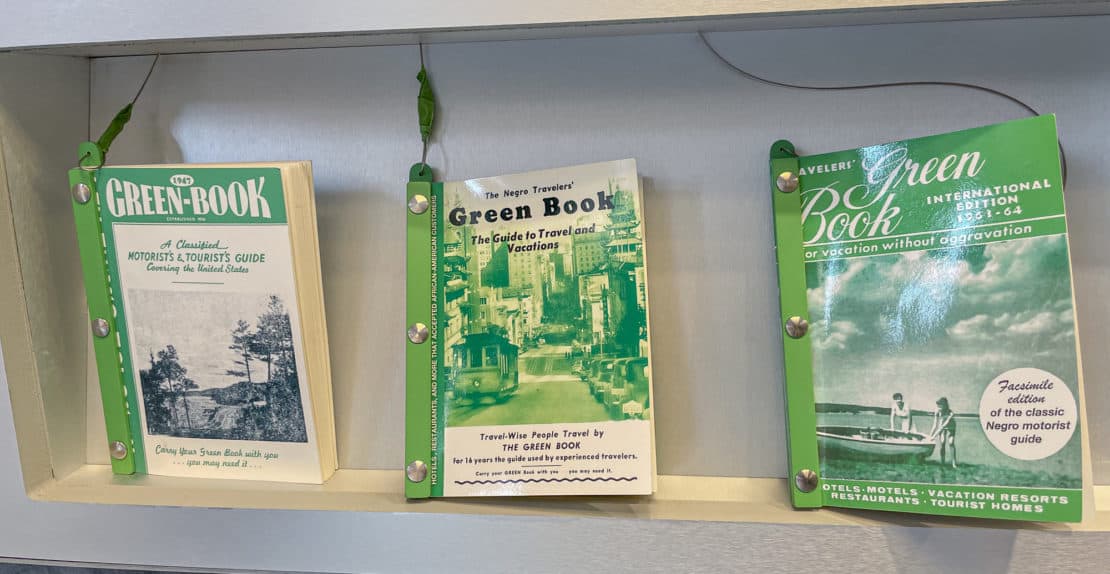
The Freedom Riders
Depressingly, throughout the 1960s, African-Americans could still not travel freely and safely. The Green Book became a kind of travel bible to help African-Americans cross their country with the least risk of violence and death.
As you enter the museum, the soundtrack of an angry mob welcomes you as you walk past bricks and coca-cola bottles, the weapons thrown at travellers who arrived here in Montgomery in 1961.
A group of volunteers, the Freedom Riders, all under 21, had travelled across the country ignoring and protesting against segregation rules on buses and in depots in a non violent manner.
They were met with violence in Montgomery.
Once again, the passion and the welcome from the staff catches my breath. They are so dedicated and so focused on the future. It would be understandable to encounter a sense of bitterness, rage or resentment but instead I hear great wisdom. Is it actually, then, possible to move on from those emotions and to look ahead and focus on love?
“We don’t know why those white people were violent that day,” one told me. “And we know we’re missing half the story. We keep sending invitations out as we want to hear everyone’s story. But only the Freedom Riders respond.”
Speaking of which, one is coming to speak this afternoon. Could we adjust our schedule to get back in time?
It’s too good an opportunity to miss. And so, we scrambled to the next spot, racing against time to return.
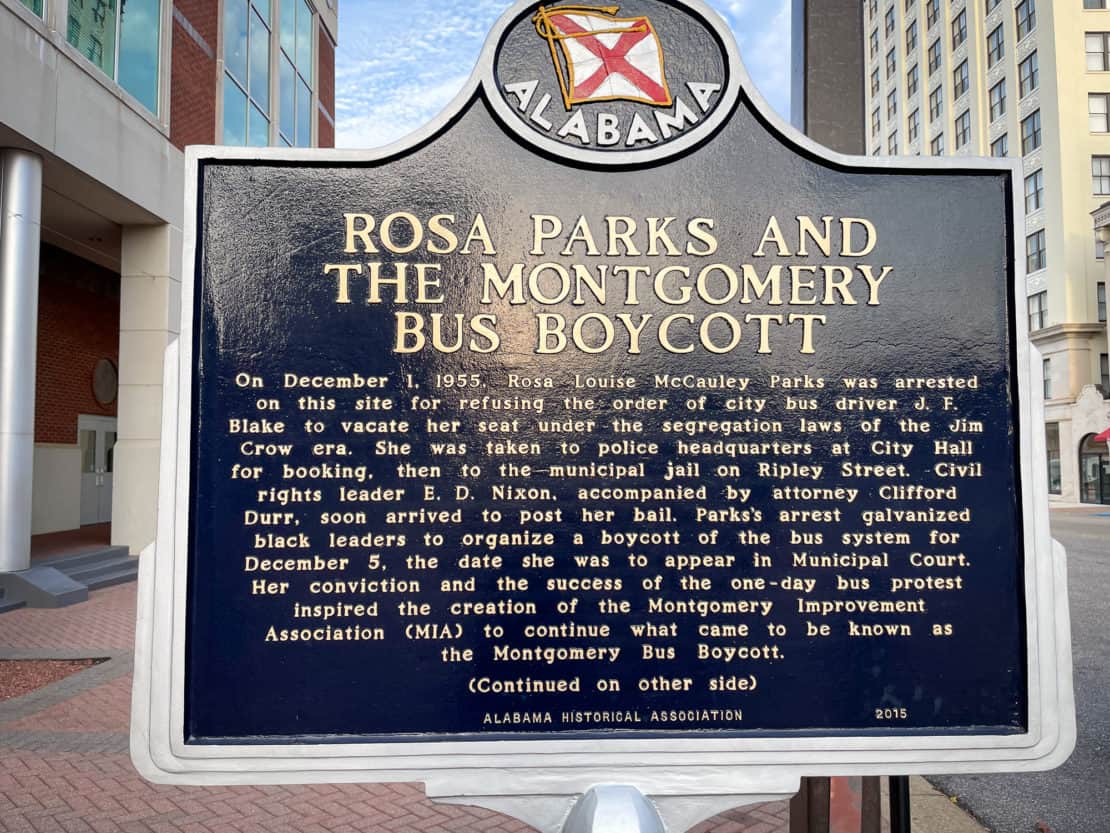
Rosa Parks and Civil Rights in Alabama
If there’s one story we tend to know fairly well, it’s the story of Rosa Parks. The woman who took a stand by sitting down and whose small act of protest triggered a wave of social change. Her story inspired the name for my own daughter, among many others, I’m sure.
The Rosa Parks Museum sits right by the bus route that marked that fateful day. And what’s surprising is that the route is short. It really didn’t take long for the bus to fill up and the conflict to begin.
The second thing to note is just how organised that moment of protest had to be. The museum catalogues the meetings, the pamphlets, the lift shares and the sheer amount of community work that changed a single arrest into the 13 month Montgomery Bus Boycott that followed. The protest that ended in the Supreme Court with the decision that segregation was unconstitutional.
We flew through the exhibits, scarcely doing them justice in order to race back to hear Dr Lafayette, a man who spend 40 days in jail as a Freedom Rider and proponent of nonviolence for social change. A man who told us that “every day I wake up, I’m surprised to still be alive.”
If ever an experience is going to reinforce how recent all this was, it’s speaking to someone who was there.
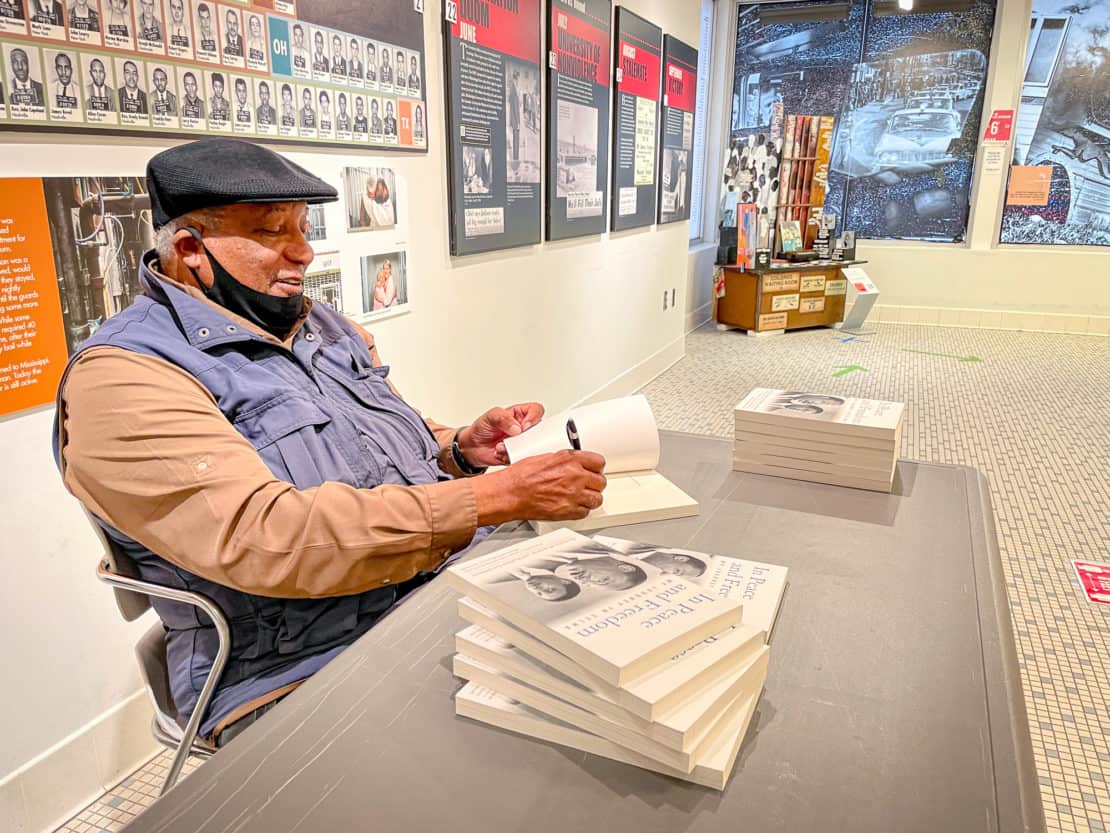
Birmingham, Alabama
The frenetic pace of Montgomery smoothed a little by the time we reached the industrial machine of a city in Birmingham.
The Birmingham Civil Rights Institute catalogues the procession of dark history and pain as well it might. Unlike the places on Montgomery Civil Rights Trail, the CRI provides more of an overview, with a more academic feel.
And then the 16th Street Baptist Church just across the road takes you right back to the individual events. For it was here where KKK members murdered four young girls at Sunday school in a place that still throbs with pain.
“We have congregation members who still feel afraid of anyone white,” says one guide.
For now, the girls live on in haunting sculptures across the road in the Kelly Ingram Park.
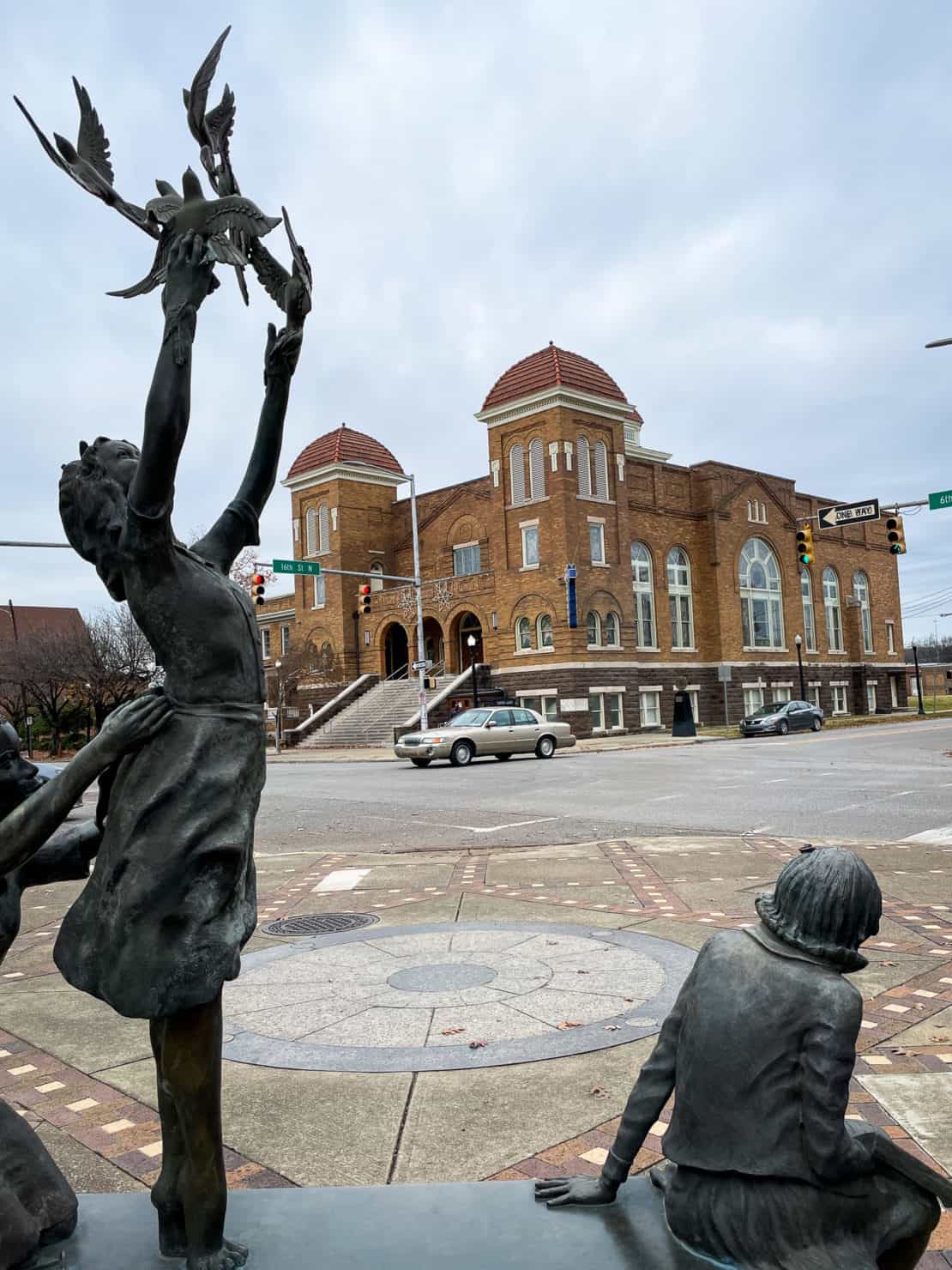
Why Are We Here?
With time off work in short supply for many of us, visiting these places brings, or uncovers, heaviness in the soul. It prompts and provokes questions from dawn til dusk, as many forms of dark tourism or thanatourism often do.
A few months back, I wrote my thoughts on the question of whether or not dark tourism could ever be ethical. Is visiting these civil rights monuments in Alabama a worthy endeavour or an exploitative one? For it’s surely not a neutral way to spend your time.
There is an argument, and ah, there are always arguments, that it is important to know your own history and that of your people. (There is also the counterargument that that can lead to people getting stuck in the past.)
So for those outside of the US, what is the value of visiting the civil rights trail in Alabama beyond a kind of virtue signalling?
Why America Affects Everyone
Well, from my point of view, the history of the US is more relevant than many other places precisely because of its global dominance and reach. Who has more of an influence on my daily life? My local politician or the President of the US? It’s a question with an undefined answer.
What’s more, the civil rights struggle took place so recently that it barely counts as history. You can meet and talk with people who were alive and present at the events in question.
Why World History Affects Everyone
But most importantly, and I know that many disagree, I feel that the Civil Rights history is the history of my people. Because all peoples are my people or, as Martin Luther King Jr himself said rather more eloquently, injustice anywhere is a threat to justice everywhere.
To stand in Alabama and confront reality is an important education in itself. But not if it stops there.
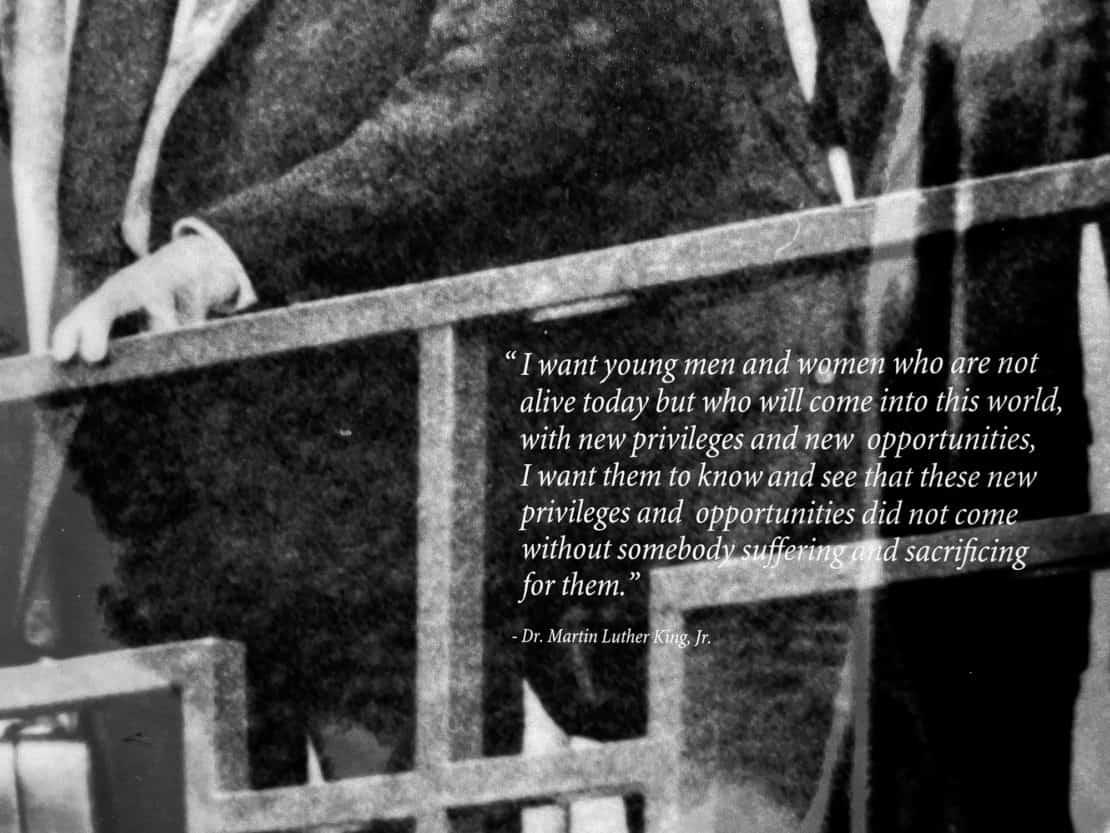
How Change Takes Place
To stand in Alabama and to retrace the footsteps of Martin Luther King Junior and to see the bus route that Rosa Parks used is also a lesson in the power of change.
The stories of these heroes, heard from a distance, invokes their courage and their genius. To stand where events took place reflects another reality: their humanity. The fact that while courage and genius were in fact required, it was the dull, repetitive, everyday plodding of campaigning and recruiting and standing firm which led to results. A single gesture would not have been enough on its own.
It also shows that change is possible, that progress can take place.
Racism in Alabama
Earlier, I mentioned that several Americans can told me that they couldn’t or wouldn’t visit Alabama because they believed it to be a racist place.
Even that’s a harmful sentence, worth of unpacking.
The 2021 census reveals a population of 26 % Black or African American and 68% White in Alabama. Or in the words of a member of staff at the Freedom Rides Museum, who could barely hide her frustration on the topic…
“Ultimately, it’s the state of Alabama who is paying to keep these memorials alive and running. To pay me to stand here talking to you.
And, she added. “I’m just saying that George Floyd didn’t happen in the Deep South. I’m just saying.”
“We have our problems, everywhere does. But it’s insulting to talk about us that way and to stay away.”
As ever, there is much to think on.
It’s Not All Black and White
My five year old daughter skips in the first drops of rain. Leaves rustle with a hint of menace overhead and I think a storm is coming. The sculptures she skips past show children cowering from dogs and police with weapons raised. African-American children cowering. White police with weapons.
And now, perhaps more than ever before, I see her as a white child, not just my child.
She’s young and white and doesn’t understand why people used to be so mean.
And it all feels so complicated. Should I even be writing this piece when I’m white? Is this white centring at its finest? What, exactly, am I doing here?
The Kindness of Strangers
I’m still fumbling with these thoughts as we try to buy lunch, messing up the credit card PIN and trying to work out the exchange rate. A hand reaches across and taps their card onto the reader. An African-American hand.
“Let me get it,” she says, introducing us to her daughter who’s about the same age. “We like to practice random acts of kindness around here.”
We try to hand her the money, flushed, embarrassed, confused, but she won’t hear of it.
And that’s the biggest power in retracing dark history, from Hiroshima, to Auschwitz to here. It’s when you come face to face, not with evil, but with the blindsiding kindness of strangers.
So why should people visit the Civil Rights Trail in Alabama?
To learn? To pay respects? To be blamed? To be forgiven? To be humbled? To feel love?
Perhaps it is all of those things.
And now on to the more traditional travel guide…
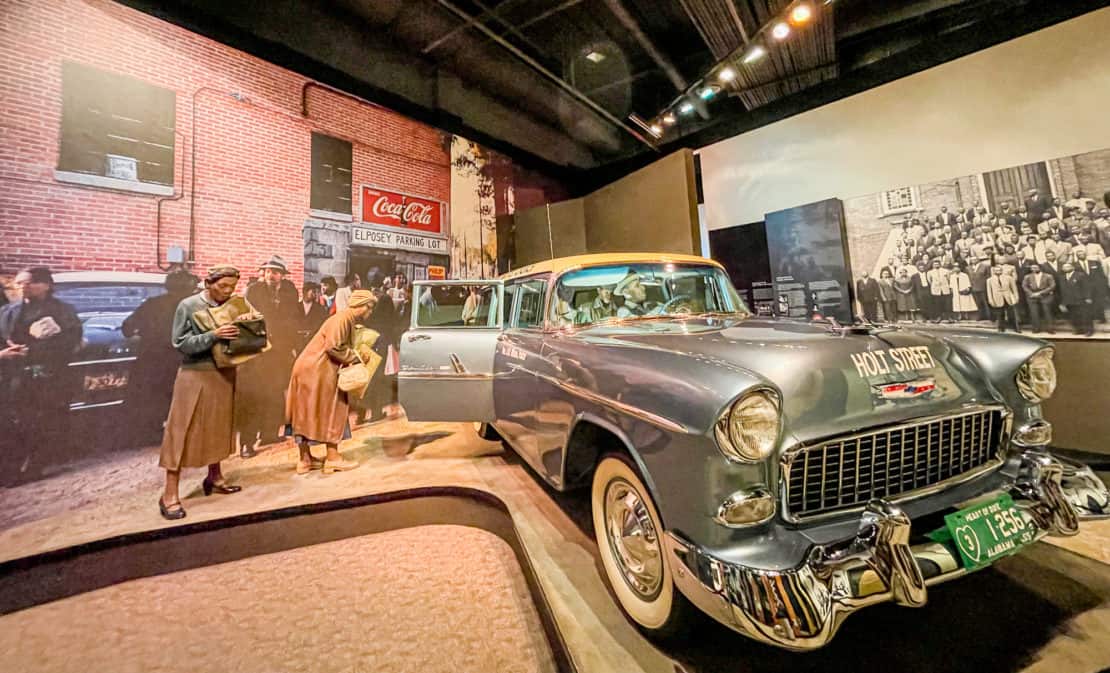
A Travel Guide to Key Civil Rights Monuments in Alabama
When it comes to retracing the history of civil rights in Alabama, there are many places you can go. But these are generally considered to be the most important. You may want to add in the Edmund Pettus bridge from the Selma to Montgomery march and the new Legacy Museum: from enslavement to mass incarceration.
Dexter Avenue Church (Former Church of Martin Luther King Junior)
Located just a few steps from the Alabama State Capitol, Dexter Avenue Church is a chief landmark in the history of the American Civil Rights Movement. It is the place where Dr Martin Luther King Jr. served as a pastor between 1954 and 1960 and from where he coordinated the Montgomery bus boycott in 1955, serving as a representative voice for African Americans in protest against the segregation laws.
In 1974, the church was designated as a National Historic Landmark, and in 2008, it was added to the UNESCO “Tentative List of World Heritage Sites”. It is visited by thousands of tourists every year, interested in learning more about the Jim Crow era and all the struggles and sorrows of the Civil Rights Movement.
The main attraction point is the mural painted by artist and deacon John W. Feagin representing Martin Luther King Jr.’s journey from Montgomery to Memphis as a leader of the Civil Rights Movement.
The former Dexter Parsonage is also open to visits. This was the place where pastors lived between 1920 and 1922, so Dr King’s temporary home as well. The rooms form a museum that displays information about the segregated facilities before the Civil Rights Act outlawed the practice in 1964.
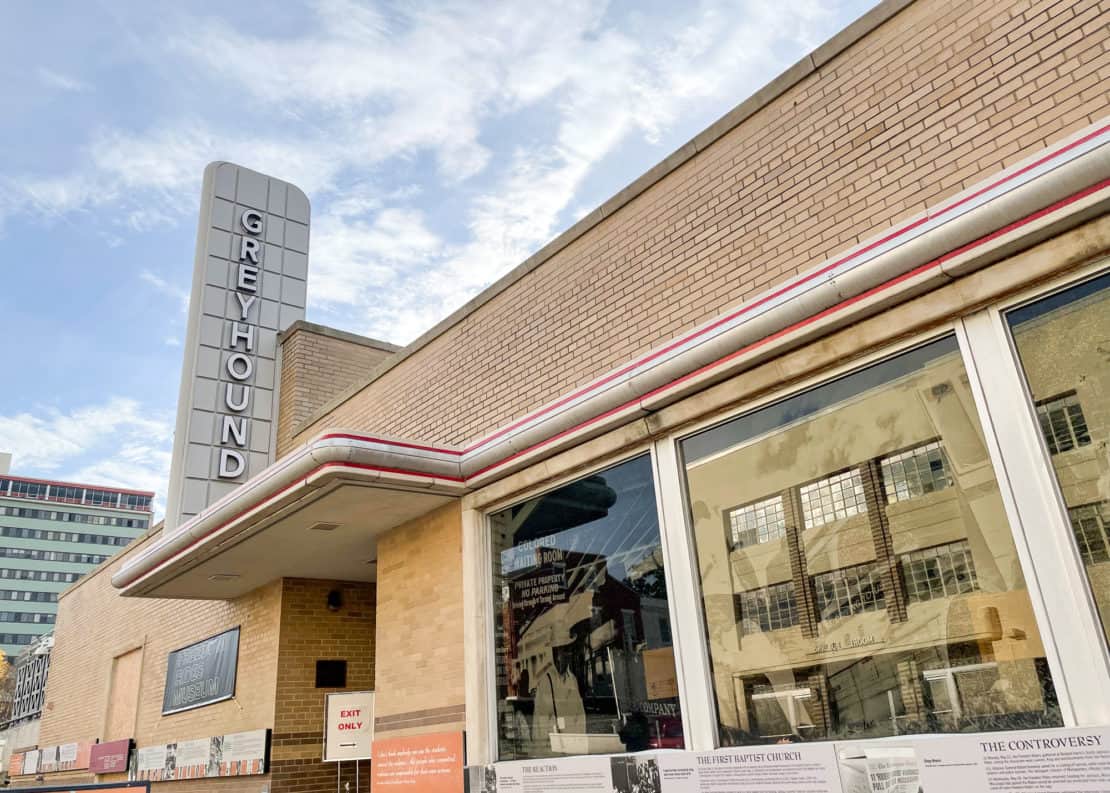
The Freedom Rides Museum
In 1961, a group of volunteers who called themselves Freedom Riders decided to challenge the segregation practice applied to public transport. Men and women, black and white, all extremely young, embarked on a Greyhound bus and travelled through a series of states in the South before stepping off in Montgomery, Alabama. They rode, breaking all the rules, the African-Americans taking seats in the front of the bus next to their white friends, knowing they would likely face violence at the end. Many had already written their testaments and farewell letters.
The Freedom Rides Museum stands on the place where the Riders ended their trip. They were received by an angry mob that smashed the reporters’ cameras before attacking the travellers. Although the police had promised protection, they were nowhere to be found.
However, this protest, along with other movements for civil rights, like Rosa Parks’ statement and the bus boycott in 1955, pushed the Kennedy administration to recognise the right of African-Americans to use the same facilities as white people and to occupy any seat that is free on a bus.
The old bus station was restored to its original 1961 looks, and you can even see a bus that was in circulation during the protests. It is definitely worth making a stop to listen to the Riders’ confessions, which were recorded later.
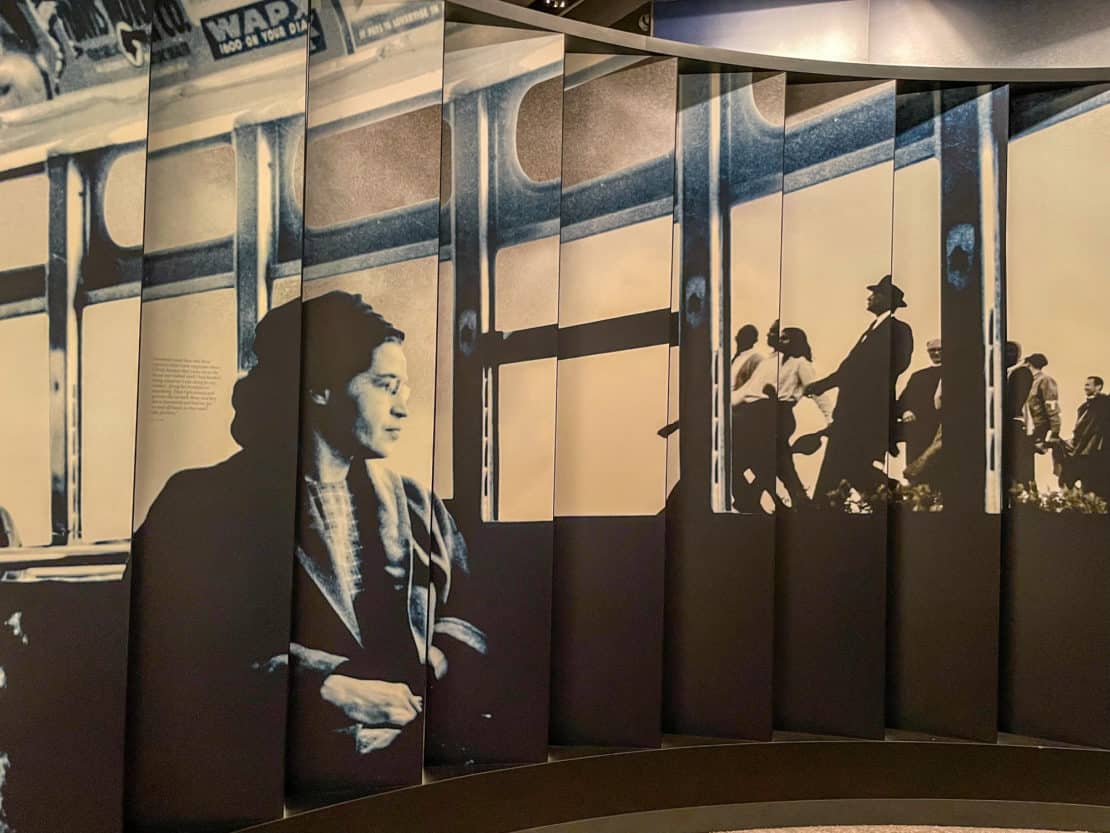
The Rosa Parks Museum
A very short walk from the Freedom Rides Museum, you will find another small but very important landmark in the Civil Rights Movement history. The Rosa Parks Museum, managed by Troy University, takes you on a vivid journey about the strength of sitting down when standing up meant to surrender.
It is placed in downtown Montgomery at the site where Rosa Parks was arrested for refusing to offer her seat on the bus to a white person when the front seats were all taken. This act of rebellion sparked the bus boycott, and Mrs Parks was an inspiration for the protesters.
Here, you can see the original fingerprint arrest record of Rosa Parks, court documents from her trial, as well as different artefacts related to her life and the 1955 bus boycott that followed. The museum also has on display a city bus from the 1950s resembling the one Rosa Parks rode on her regular route to and from work and a 1956 station wagon the police used to transport protesters.
As an aside, you can see the actual bus where Rosa Parks sat as part of this Detroit itinerary here.
The Birmingham Civil Rights Institute
As one of the best places to discover the history of the Civil Rights Movements, the Birmingham Civil Rights Institute houses over 500 recorded oral histories, along with many artefacts and documents that can help reconstruct the Jim Crow era. A visit to the museum will send you back to 1950 into a segregated Birmingham where African-Americans were still not allowed the same rights as white Americans, being forced to use separate water fountains, restrooms and schools and facing huge obstacles in trying to vote.
Stop to look at a replica of a Freedom Riders bus and try to imagine how the Riders’ hearts boomed as they approached Birmingham station. The door from Martin Luther King Jr.’s cell in Birmingham is also here, and it is a great experience to learn that, just behind it, he wrote one of the most famous documents in America’s history, the “Letter from Birmingham Jail.”
The 16th Street Baptist Church
One year before the Civil Rights Act was signed, the Civil Rights representatives in Birmingham were pushing hard for their rights to be acknowledged. This led to a strong reaction from the members of the Ku Klux Klan, who responded through a series of bombings at the movement leader’s homes and the movement’s alleged meeting points. One of them was the 16th Street Baptist Church.
On September 15, 1963, four members of the Klan planted dynamite sticks inside the church, which exploded that Sunday morning, killing four girls and injuring more than 14 other people.
Today, the church continues to function as a religious site for its community, but visitors can book a tour to learn more about the tragic events that took place there. The tour includes a lot of information on the desegregation movement and the bombing and it’s impossible to visit this place and to leave unmoved.
Practical Travel Tips for the Civil Rights Trail in Alabama
There is a lot to see on the Civil Rights Trail in Alabama – and depending on how much time you have in the area, it can feel overwhelming. Check out our Alabama road trip itinerary to see how we balanced education and paying our respects with exploring the rest of the state.
Another thing to bear in mind is the depiction of violence and its impact on children. The Rosa Parks Museum, Dexter Avenue Church and the Freedom Rides Museum talk about violence but in a way that’s not traumatising for children.
The Birmingham Civil Rights Institute has a compulsory introductory video which shows lynchings. And the 16th Street Baptist Church has a multimedia display about the deaths of the young girls, which may also be terrifying for young children.
We were advised to avoid the Legacy Museum with our then five year old daughter but hope to return when she is older. The general opinion seemed to be that a visit would be too traumatic.
If you’d like to see a different part of the state once you’ve completed the civil rights trail, consider a trip to the Smoky Mountains or a weekend in Gatlinburg.
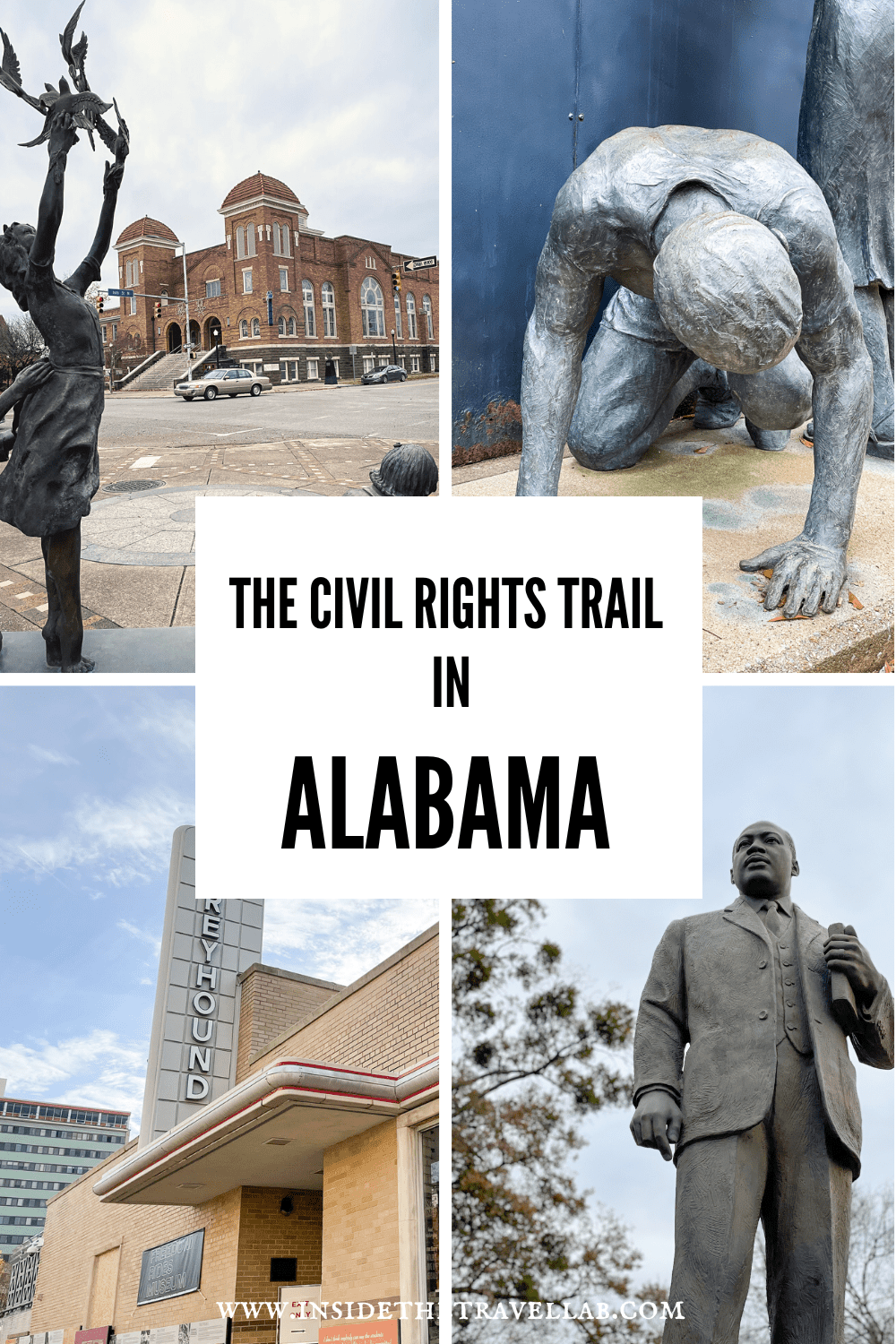
In Conclusion: Why Everyone should visit the Civil Rights Trail in Alabama
- To understand more about the biggest superpower in the world
- To understand more about the patterns of racism
- To understand the mechanisms of change: courage, genius and also dull, dull community plodding and planning.
- To challenge our preconceptions – to see another side of Alabama.
- To be inspired. This story of progress belongs to everyone.
- To be humbled
- To feel love
How to Plan Your Trip to Alabama
You can either build a DIY trip with one of our self-guided Alabama itineraries or partner with a trusted tour operator to get the best deals. We partnered with America As You Like It and they truly did find better flight deals than me – a shock after years of professional flight hunting!
Check out our other articles on travel in Alabama here:
- What is Alabama known for? 101 Fun facts about the Yellowhammer State
- Meet the real Maycomb from Harper Lee’s Mockingbird
- The best things to do in Gatlinburg for couples
- Great fun facts about the Smoky Mountains
- The best Alabama road trip itinerary for your next trip

